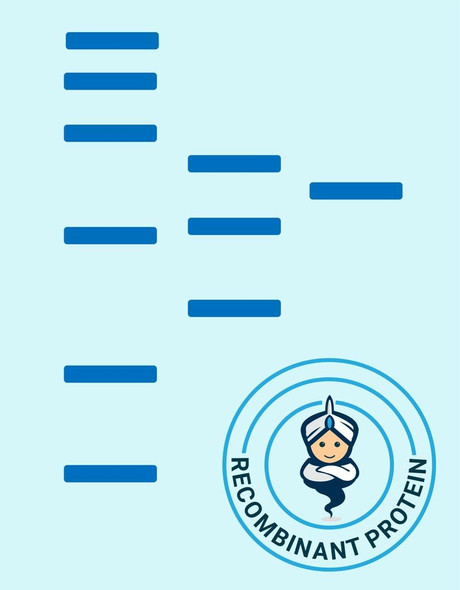Human C12ORF5 Recombinant Protein (RPPB2929)
- SKU:
- RPPB2929
- Product Type:
- Recombinant Protein
- Species:
- Human
- Uniprot:
- Q9NQ88
Description
| Product Name: | Human C12ORF5 Recombinant Protein |
| Product Code: | RPPB2929 |
| Size: | 25µg |
| Species: | Human |
| Target: | C12ORF5 |
| Synonyms: | Fructose-2,6-bisphosphatase TIGAR, TP53-induced glycolysis and apoptosis regulator, TIGAR, C12orf5. |
| Source: | Escherichia Coli |
| Physical Appearance: | Sterile Filtered White lyophilized (freeze-dried) powder. |
| Formulation: | TIGAR was Lyophilized from a 0.2�m filtered concentrated solution in 20mM PBS, pH7.0, 350mM NaCl and 5% Trehalose. |
| Solubility: | It is recommended to reconstitute the lyophilized TIGAR in sterile 18M-cm H2O not less than 100�g/ml, which can then be further diluted to other aqueous solutions. |
| Stability: | Lyophilized TIGAR stable at room temperature for 3 weeks, should be stored desiccated below -18C. Upon reconstitution TIGAR should be stored at 4C between 2-7 days and for future use below -18C. For long term storage it is recommended to add a carrier protein (0.1% HSA or BSA). Please prevent freeze-thaw cycles. |
| Purity: | Greater than 95.0% as determined by: (a) Analysis by RP-HPLC.(b) Analysis by SDS-PAGE. |
| Amino Acid Sequence: | MARFALTVVR HGETRFNKEK IIQGQGVDEP LSETGFKQAA AAGIFLNNVK FTHAFSSDLM RTKQTMHGIL ERSKFCKDMT VKYDSRLRER KYGVVEGKAL SELRAMAKAA REECPVFTPP GGETLDQVKM RGIDFFEFLC QLILKEADQK EQFSQGSPSN CLETSLAEIF PLGKNHSSKV NSDSGIPGLA ASVLVVSHGA YMRSLFDYFL TDLKCSLPAT LSRSELMSVT PNTGMSLFII NFEEGREVKP TVQCICMNLQ DHLNGLTETR GGYGRKKRRQ RRR |
| Biological Activity: | The Specific Activity was measured by its ability to protect U2OS cells from apoptosis induced by hydrogen peroxide is in a concentration range of 0.1-5.0 �g/ml, after pretreating with rHuTIGAR-TAT for 4 hours. |
TIGAR is a p53-inducible enzyme which catalyzes the hydrolysis of fructose-2-6 bisphosphate (F-2-6-BP) to fructose-6-phosphate and inorganic phosphate. F-2-6-BP is an influential activator of 6-phosphofructose-1 kinase (the rate limiting enzyme of glycolysis). By lowering the intracellular level of F-2-6-BP, TIGAR expression leads to increased glucose processing through the pentose phosphate pathway, the main cellular source for NADPH. Protein transduction using TAT fusion proteins represents an alternative methodology for introducing transcription factors and other intracellular proteins into primary as well as transformed cells.
TIGAR Human Recombinant produced in E.Coli is a single, non-glycosylated polypeptide chain containing 283 amino acids (including the 270 residues of full-length TIGAR and a 13-residue C-terminal TAT peptide) and having a molecular mass of 31.7kDa. The TIGAR is purified by proprietary chromatographic techniques.
| UniProt Protein Function: | TIGAR: Fructose-bisphosphatase hydrolyzing fructose-2,6- bisphosphate as well as fructose-1,6-bisphosphate. Inhibits glycolysis by reducing cellular levels of fructose-2,6- bisphosphate. May protect cells against reactive oxygen species and against apoptosis induced by tp53. Belongs to the phosphoglycerate mutase family.Protein type: EC 3.1.3.46; Phosphatase (non-protein)Chromosomal Location of Human Ortholog: 12p13.3Cellular Component: cytoplasm; cytosol; intracellular; mitochondrial outer membrane; nucleusMolecular Function: bisphosphoglycerate phosphatase activity; fructose-2,6-bisphosphate 2-phosphatase activity; protein bindingBiological Process: apoptosis; autophagy; dephosphorylation; fructose 1,6-bisphosphate metabolic process; fructose 2,6-bisphosphate metabolic process; gene expression; negative regulation of glycolysis; negative regulation of programmed cell death; positive regulation of DNA repair; regulation of pentose-phosphate shunt; response to DNA damage stimulus; response to gamma radiation; response to xenobiotic stimulus; transcription initiation from RNA polymerase II promoter |
| UniProt Protein Details: | |
| NCBI Summary: | This gene is regulated as part of the p53 tumor suppressor pathway and encodes a protein with sequence similarity to the bisphosphate domain of the glycolytic enzyme that degrades fructose-2,6-bisphosphate. The protein functions by blocking glycolysis and directing the pathway into the pentose phosphate shunt. Expression of this protein also protects cells from DNA damaging reactive oxygen species and provides some protection from DNA damage-induced apoptosis. The 12p13.32 region that includes this gene is paralogous to the 11q13.3 region. [provided by RefSeq, Jul 2008] |
| UniProt Code: | Q9NQ88 |
| NCBI GenInfo Identifier: | 74734311 |
| NCBI Gene ID: | 57103 |
| NCBI Accession: | Q9NQ88.1 |
| UniProt Secondary Accession: | Q9NQ88,B2R840 |
| UniProt Related Accession: | Q9NQ88 |
| Molecular Weight: | 30,063 Da |
| NCBI Full Name: | Fructose-2,6-bisphosphatase TIGAR |
| NCBI Synonym Full Names: | TP53 induced glycolysis regulatory phosphatase |
| NCBI Official Symbol: | TIGAR�� |
| NCBI Official Synonym Symbols: | FR2BP; C12orf5�� |
| NCBI Protein Information: | fructose-2,6-bisphosphatase TIGAR |
| UniProt Protein Name: | Fructose-2,6-bisphosphatase TIGAR |
| UniProt Synonym Protein Names: | TP53-induced glycolysis and apoptosis regulator |
| Protein Family: | Fructose-2,6-bisphosphatase |
| UniProt Gene Name: | TIGAR�� |
| UniProt Entry Name: | TIGAR_HUMAN |










